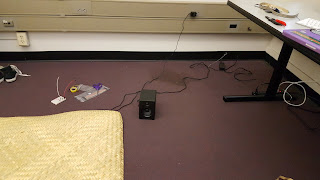My parents had the mat rolled up under the bed for so long I had to use books to flatten it out.
I was going to try to interlace the pressure sensor through the weaving of the mat itself. I wanted the viewer to look at the sensor but I found that the way in which it was interlacing affected the parameters of the coding too much. Katerie had mentioned to me with my prototype that foam would work better so that there was more variety in the pressure. Charlie suggested the same thing as well. I decided to keep the sensor hidden to keep some of the mystery of how the mat works. I think it works best because the viewer will not know exactly how the piece functions and would focus more on the content
i sewed patches of cloth into the back of the mat. The sewing is unseen from the front of the mat. I didn't want to stick the velcro straight onto the mat because I didn't want to damage it.
This is how it looks from the front. The stitching is totally hidden :)
Here is a picture of the prototype on a breadboard before I soldered it.
I plugged a speaker to the wave shield and the piece was installed. I did have a panic moment an hour before critique because my wires fell apart and my sensor broke. These sensors are so sensitive to falling apart when soldering a wire to them :( Fortunately I was able to solder it back together and Dreezy gave me a spare sensor she had and it was back to business!!!!!
click here to hear all the sounds on the mat
A problem I encountered with the sound files was that if the bit sample was higher than 16 it would not play. There were two other sounds on the sd card such as roosters and fire sounds that didn't play because of this reason.






















No comments:
Post a Comment